“Who allowed you to do this?” Joe Sparks talks Spaceship Warlock, CD-ROMs, $8000 computers, and the growth of interactive media 
Though now largely written out of gaming histories, Spaceship Warlock was a harbinger of the future of interactive multimedia. Released for Macintosh in 1991, it was among the first ever CD-ROM games, likely the earliest to use the multimedia authoring platform Macromedia Director that would become common throughout the era. Its combination of interactivity with high-quality visuals and digital audio were unprecedented at the time. Warlock made waves on release for its interactive and open-ended world, though the game’s buzz was eclipsed by the enormous success of Myst shortly after.
No one had ever attempted a game on the scale of Spaceship Warlock, either from a technological standpoint or in the overall scope of its interactive world. I wanted to figure out what it was like developing a pioneering CD-ROM for which no model really existed.
Spaceship Warlock co-creator Joe Sparks was kind enough to sit down with me via videochat for an hour to talk about the development of Warlock, working on games at the dawn of the CD-ROM era, the technical constraints faced, and visions of the future of interactive mediums. Sparks now works on animations for Google’s sales department, but he is still extremely energized about memories and lessons from this older, experimental era of game development. He shared a lot of great anecdotes and insights about how he and co-creator Mike Saenz embarked on a game project that, based on what he described, probably should have been impossible.
Developing Warlock
The beginning
Joe Sparks: How I came to do Spaceship Warlock was Mike Saenz in Chicago saw me speak at a panel. I was in the NASA Ames Research Mission Mars program doing 3D robots and robots you could control by manipulating 3D graphics on the screen. It would send a command out to a big robot that would do whatever you did with your little robot on the screen. I was showing off all this work, and [Saenz] was like, “This is the guy to work on a space-type game with me.” He had previously released something called Virtual Valerie, which was… it was kind of like a cheap… well, it was beautifully designed, but it was ultimately kind of like a soft-softcore porn-type… thing where this girl would do things with a couch and… not much else happened. It was really, really tame. But it did receive a lot of attention in a weird kind of […] direction.
Mike Saenz was also known for Iron Man and some of the first digital comics ever. Shatter, which is still really highly regarded as the first. He used a Macintosh computer. For a comic, it was the first of its kind, so he was a real pioneer in graphics and also an amazing artist, and he was like “Hey, let’s work together on a game.” I was like, “Well, I’ve got a few contracts I’m working on and stuff like that, but it sounds good.”
So in 1990, we started working on it. And at this time, it would take… oh god. To send a graphic through AOL, to send like 100kb, like the smallest graphic, it might take 20 minutes just to send him a graphic. So he’s in Chicago. [Sparks is in California.] A fax machine was our primary way of communicating. Mike Saenz would write up or draw some ideas for spaceships, things that would happen, some ideas, he would send them over to me, and I would build them all in 3D and start to build the game. My primary responsibility was all of the animation, programming, graphics, and music, too. We were a pretty good team there for a long time, and nine months later, out comes Spaceship Warlock. And to our shock and surprise, first of all, a lot of buzz came.
Surprising first impressions
We had wanted to finish by January [1991] MacWorld, which was impossible. It was impossible. It was like “Four months later, we’re gonna do a game?” We had an incredible demo of a big chunk of it in four months, so we had a booth at MacWorld San Francisco, and we showed off what we had. And I remember this one time, there was this team of Japanese people who came from Sony or somewhere else, and this lady was like, “What? What is this? What is this?!” We were like, “Well, it’s a game we’re working on. It’s not ready yet, but it will be ready soon.” She was like, “How? Who allowed you to do this?” I’m like, “No one allowed us to do this. We just did it ourselves.” They’re like, “No. That’s not possible.” Like there must have been a government edict that said “Make Spaceship Warlock.” They could not comprehend that two guys would just get together and build this thing.
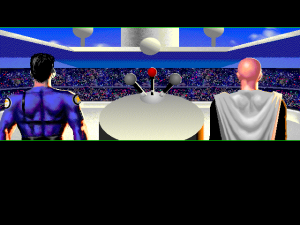
“They could not comprehend that two guys would just get together and build this thing. They were really astonished, and so was everyone.”
They were really astonished, and so was everyone. Trip Hawkins, who was CEO of Electronic Arts at the time, the head founder of that great company, came knocking on my front door. We ended up having lunch and meeting, and a lot of things came out of that, and Japan was one of them. We ended up going to Japan several times, demonstrating on stages and meeting all these animation people, film people, and being on TV shows with famous manga artists. It was really a crazy time for me, and I was in my early 20s. It was a pretty spectacular, exciting time, and it amazes me that two guys could just sit down, bury their heads, work through Christmas Eve, work through New Year’s, and deliver something that people loved. And it won MacWorld Game of the Year and lots of other awards.
Creating a language of interactivity
[Spaceship Warlock] is really just a series of little interactivities in a very linear story. So you start out on Stambul, the city, and you’re just in an alley with no explanation. Like “Hey, here you are, let’s start walking through the city.” And so I built this 3D city with alleys and bars and hotels and videophones and all these things. You start, though, but there’s no explanation of how do you get around. There’s no, like, “Press A to go here” or whatever. It’s just like “Start clicking.” So you click in front of you, and you start to move. And this is way before any real-time 3D or anything like that. We just got bitmaps. So you click, and you move ahead a little bit, so I’m running a camera through a 3D scene, but we also make sure that you’re able to turn. Any time you come to a node, you can turn to see what’s over here, and turn to see what’s over here, and turn to see what’s behind you, but there’s only four views at any one spot that you can click.You had to establish that when you clicked on things, did they create something? Did they create an interaction? Do they cause anything, right? So there was an idea of moving when you click to move – I’m moving, I’m moving – and then you see a little door. Do I click on the door? What happens, right? We needed to establish that when you click on doors that something might happen, or if it did happen we had to have kind of a visual cue. Because it’s really hunt-and-peck, like “What am I doing? What works here?”
And so very early on, I worked myself into a box since we had no interactivities until you turned the corner and saw the bar. Then you could go inside the bar and order drinks. People loved that, it was great. But I had built a door into a wall before you get to the bar door, and we were like “Well, what do we do with the door here?” Because if you click on this door and it does nothing, when they come around the corner, they might not click because we’ve already established that doors don’t do anything, so what the hell are you gonna do? So we decide to – on that first door they encounter in the game, and I demonstrated this to many audiences, large audiences, thousands of people, at many different times, and they never expected this – the door, when you click on it, just to show you can click on doors, we made the door open with a little alien sticking his head out and goes “Use the front door!”, and they close the door. And every time I showed this stupid little thing that was really just a clue to fix the interface problem, everyone burst out laughing. I was like, “What are they laughing at?” “ ‘Use the front door!’ ” [mock guffawing]
That’s what really surprised me. Just little kinds of interactions can have a huge effect – a surprise effect, like peekaboo with babies. It’s weird how you can get so much mileage out of the simplest things.
Writing music for interactive media
The music is actually interactive in that it changes as you go. At the time, we only had single-channel sound for this kind of stuff. So we had one soundtrack, so when someone had to say something – [space pirate voice] “This is solid gold!” or whatever – the music had to stop, unless we moved that vocal into the music, which we never did because sound had to be loaded fully into memory and playing. And so you couldn’t just have many tracks happening. Today it’s like a dream. Today is everything we everything we ever dreamed of – it’s real and true today. It works beautiful. But back then, we had to worry about memory and stuff like that.
So what I did was I made a whole bunch of little loops that were, like four bars […], these little things. They were happy, then they started getting a little bit more dark, or they got a little more abstract. And as I’m classifying all these different loops into kind of “moods,” like “Oh, expansive space. We’re flying through space!”, and another would be like everyday kind of busy work, and then… it’s really trippy with lots of electronics. I tried to make R2-D2-like sounds with my Yamaha synthesizer. And I had lots of things like “robot party” and stuff like that. And then it would get really dark or energetic. War drums. But the thing is, all the timings for these was the same time.
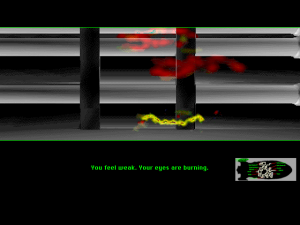
“Instead of stopping, it was a continuous music soundtrack that would evolve and change depending on what you were doing.”
I had this program tool called a HyperCard XCommand, which is like compile code that you could load into memory and tell it things. A lot of different tools, a lot of software used all kinds of compile tools to get a certain kind of benefit, like playing sound, for example. This was from Farallon Computing who had a Mac recorder product, and they created some little piece of code that people with HyperCard could use to inject sound into their cards. It turned out that this thing also worked in Director, because Director had an interface to tap into these codes. So we started using it.
We had this tool that would say “Start playing this loop indefinitely – until I say: next loop is ‘this sound.'” And instead of cutting in just right in the middle of it, just cutting sound out and playing this new sound, they would wait until it reached the exact end of that loop, and it would fly in the next loop. So that way you could have a footing of: You were looping this one part. Once you pass this door, inject the new part, because it’s starting to get a little mysterious now. So then it would slot in a new piece of music. As you go into dangers – oh, it’s getting more exciting. So instead of stopping, it was a continuous music soundtrack that would evolve and change depending on what you were doing.
The Obscuritory: Neat! So very much based on the environment, how the piece[s were] written.
Yeah.
Cheating to design action scenes
If I can be totally frank, I think [the action scenes] are the only part that doesn’t really work that well, just because it was, you know, Macromedia Director. It wasn’t very well-suited to shoot-em-ups and stuff like that. During the design of it, I’m wondering–
Like punching a guy, or..?
Yeah. “Come on Terry!” All that stuff. Honestly, it was tough.
It was totally cheap. It was like… there was just a few positions. What it was, was: an invisible target was going. It was moving with the animation. So it was like, you would try to get a chin, or you’d try to hit his fist before it hit you. It was really cheap. It was not great.
A few shooting games where you shot – that was my first game programming. [It] was like “Okay, the bullet’s traveling, and it’s hitting this…” I was doing intersection detections. That was the first time I ever did, like, basic game intersection detection. This was the first thing I actually programmed on a larger scale, so I was learning. I was literally learning, and at the time, I was going down to the used bookstore and getting math books, algebra books, like “There’s stuff I know I should’ve learned in high school!” And now I have to go to geometry suddenly when I was 20 to solve all these things. It was like, “Wow, this is golden!” I never knew I would need that stuff, you know?
Cutting their losses
We went down some blind alleys too where I tried to make a kind of like… in order to make this more game-like, you have so much fuel to get to some star, and pick up some things, and maybe do some trading along the way. [We] tried to work out some sort of game mechanics around that, which, we tossed all that. But we went down a long kind of blind alley for a month, thinking about adding that aspect to it. It ended up being way too complex. […]
Especially at the end, we were just trying to get it done. You know, like “Oh god,” just make sure it doesn’t crash or break. Just get through this. But like little Disneyland attractions, maybe not look so great, but it’s there, take it or leave it, and move onto the next thing. There’s a lot of cutting corners.
It’s, of course, in all these games – in every game that I’ve ever worked on – it’s ten percent of what was in your head. It’s the same thing with all the cartoons [I did]. I had: for Radiskull & Devil Doll, Radiskull was going to destroy San Francisco. He was going to tear up the Bay Bridge. He was going to do all these things. He was gonna rise from the ocean, or from the bay, and start terrorizing tourists in San Francisco. He was gonna grow bigger. He was gonna get shot at by jet fighters that were gonna attack him. I had all these plans, right? The story that played out in Radiskull & Devil Doll… I have books of all the things I wanted to do and storyboards that I never ever had the time to even begin to do.
It’s kinda like that with any movie or any project. It’s like, you’ve got a lot of ideas, but at some point reality sets in. And you have to just let things go, let things be where they are, stop polishing, and ship it.
Technicals
Storage restrictions and the CD-ROM revolution
One of the biggest limitations of Spaceship Warlock was the size of the hard drive I had, the size of the largest hard drive. So this seems incredible. Right now on my camera… [He grabs his camera.] This guy right here. I have a memory card inside of this camera that cost me $100 a few weeks ago. It is 256 gigabytes. Gigabytes! But in 1990, I paid about 800-something dollars for a 128 meg hard drive. Actually, I think it was 120. 120 megabytes! It was an external hard drive. My internal hard drive was 40 megabytes. Suddenly I have a full 120 megs. Now they were, at the time… 120 megs, I mean, ugh. That’s so small. I mean, my last three sentences generated 120 megs of video, right? But in this time, hard drive space was very expensive.
The big revolution of CD-ROMs was, we’re going from floppies. I don’t know if you ever remember the era, you installed floppies to install a new program, and it came with like a sleeve of floppies, and you had to eject and inject until you got this program on your hard drive. So it sounded like for the same price as a floppy, for 650 megabytes on a disc that costs like, less than a dollar to produce. That was the thing. That’s why everyone was going nuts. We had a mini, kind of pre-Internet boom where people going “Holy crap, we can do all this digital media for very cheap. We can get it all over the place.” So that’s what made Warlock possible.
But personally, I was the one with the biggest hard drive sitting on my desk. 120 megs. What was the size of the files on Spaceship Warlock? It’s 120 megs, the same size as my external hard drive. We couldn’t go any further. I couldn’t pay. It would be like $3000 to get a 600 meg hard drive. And so what’s even crazier is that the final build was on the hard drive – the only copy of it in existence. All of my other files were on floppies, and I still have shoeboxes filled with floppy disks of all the art and all the scenes, and all the pieces, and all the music files, and all the MIDI music files, and all that. And all the voice-over recordings, and so on.
So what happened when we wanted to make a master: I would pack my precious 128 meg hard drive, wrapped in foam and whatever, and go to DHL, and have it sent off to make a glass master of the contents of that hard disk. They would send a couple discs – one to me, one to [Saenz] in Chicago – and we would test test test, test test test, test test test. Then finally, after doing this about three or four times, we had the final master, ship it to manufacturing, had it pressed in a disc, and had it put in boxes.
That was the reality at the time. We simply didn’t have physical space. There’s lots of reasons [why the game wasn’t larger] – the time and effort, even the size of the memory space inside your computer to build a 3D city. Like, you really had to chop. You had to make a really small little playground, and then you give it time. But yeah, I mean, given the constraints, it still was a really fun little thing, and people really liked it, and I still meet people all the time who are like “Oh, I played that when I was a kid, it’s great!”
…and the CD-ROM’s drawbacks
One of the things that people can’t appreciate today is CD-ROMs were slower than 57k baud modems. Way slower! They were more like a 24k baud modem. They were so slow, so the graphics – plus, there was no compression [like] a JPEG! There was no compression on audio. There was no compression [like] MP3. So really low-quality audio and really low-quality bitmap graphics were much larger in filesize than our beautiful JPEGs in full rich color, or beautiful sounds and an MP3 file at a high quality. Those files are so much smaller, but in those days it took so much longer to pass the file, so we’re just paying for it in ways you can’t imagine.
The first Apple drives were $1200, and they were single speed. At the time, that was just what they were; we didn’t know what “single speed” was until people had a 2x and a 4x and a whatever. But at the time, there was so many limitations.
Selling a game as a luxury item
At least at first, we were only on Macintosh. Later it was released for Windows. At the time, the Macintosh was usually pretty far ahead in multimedia capabilities. Especially at that time, there was no choice. Windows 95 changed everything, but before Windows 95? There was nothing. I mean, multi-channel sound, graphics, et cetera, was the Macintosh was the only place for it.
Now, the thing is though, it was still a very elite thing. Which was great, because we could charge a lot. We charged $100 for the game. And everyone thought “Pfft, of course!” Because first of all, if you were one of the people who spent $1200 for this rarefied weirdo thing called a CD-ROM drive from Apple, who was the first to publish the thing and put it on the market? This was a market of people who were spending like… my first Macintosh II that I paid for with my own money? To get the Mac IIfx and the color card and the other things that I needed for this Mac, was exactly $8500. That’s how much it cost. That’s to have a cutting edge Mac that worked pretty well with 3D. I thought it was a speed demon when I got it. I couldn’t believe how great it was. Of course my phone is 40, 50 times the power of it. So that’s what I worked on on Spaceship Warlock was this Mac that, through my NASA earnings, I was able to purchase.
It turns out that, on the flipside, $100 for somebody who spent $1200 – and perhaps $7000 on a machine – $100 to get anything decent out of this expensive arrangement was a steal! So Spaceship Warlock was the first thing that verified that “Hey man, I am on the cutting edge of… something! I can do this, and no Windows machine can do that!” And so it became a big-selling thing. But we’re still very early, and unfortunately, we’re sandwiched between – even though we made like $4 million in the first few months of selling this thing – we were still sandwiched between way-early adopters, new adopters, and the max of adopters that would happen a year or two later.
When Myst came out, which was more elaborate than Spaceship Warlock, took advantage of the rapidly growing changes in computers, and so on, they had a runaway hit that made tens of millions of dollars. So our little $4 million that rapidly fell off was great, but it was, you know, we were just a little too early. It was rough. We could have made a lot more, but really it was okay. I learned a lot. It was fun.
The big picture
The dawn of multimedia
It was an exciting time that the idea of interactive multimedia was starting to take root. In 1988, I went to a conference with Jean-Louis Gassée. It was called the Interactive Multimedia Conference from Apple, and everyone was getting really excited about animation, graphics, video, and these things coming together in these new interactive ways. It was really new. Games had existed for a long time, but your graphics were… you know. Digitized sound, photography, those kinds of things just didn’t exist on computers until – or hardly at all until – the late 80s. Then the graphics cards were getting better and so on. And so it was kind of an exciting time.
CD-ROM games within the gaming industry
I looked at what was coming out at the time of Spaceship Warlock, and it was Sonic the Hedgehog and Super Mario World and all that.
Oh yeah.
Did you guys really consider yourselves part of “gaming” in that sense? Did you think of yourselves as being, you know, these are our competitors and this is the industry we’re in? Or since you mentioned that this was kind of like a new interactive media thing, was it separate from that? Did you consider what you were doing “games”?
It was completely separate from that. I had a Genesis, I had a TurboGrafx-16, I had a Super NES. I played all these games. I met the developers. I met people at Sega, I met people at Sony. I met all these people during that time, because we were players. But we were players in this different, weirdass computer area. But everyone was watching us very closely, because that was kind of where they were going eventually. But at the time, we didn’t think of that. We thought we’re like this niche little computer boutique software developer, right?
But at the same time, I worked on Desert Strike for Sega Genesis. I did all the helicopters and all this stuff for that game. I worked on Garry Kasparov’s Chess [possibly Kasparov’s Gambit]. I did all the chess pieces and chess boards and so on. I worked on lots of games. I did stuff for different games as just an artist and a developer. I worked a lot on games for the consoles as well. But my main thing, Spaceship Warlock, was not a short-term “Hey, build a bunch of helicopters.” This was like, “Invest your entire life in building a whole world from scratch with whatever you’ve got,” you know?
The future of interactive media
There’s an article you put on your site, it was Denise Caruso in [Digital Media] talking about the minimalist interface of [Spaceship Warlock] and that there’s a low barrier of entry, and that was very much the future of games. You mentioned other people were observing where that was going. Did you really, at the time, realize you were onto something that would be big in the future? Because right now in games, there’s all this… battle for the heart and soul of what games should and shouldn’t be, and it’s kind of going in that direction. Did you know you were hitting on something with that when you started it? Did you know this was where everything was going?
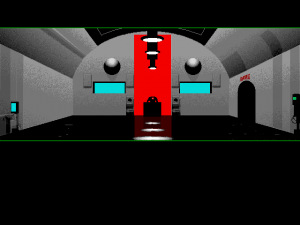
“I just knew very early on that eventually, the medium would become very sophisticated, and you could build worlds.”
Not so much for interface. I just knew very early on, from my first Commodore 64, that eventually, the medium would become very sophisticated, and you could build worlds.
I used to work for VPL. Those are the guys who invented the term “virtual reality.” And I used to work with Jaron Lanier and Young Harvill and all those pioneers that invented the whole virtual reality thing from […] dual stereo vision. You had two Iris workstations that powered each eye that cost $100,000 each. This was virtual reality in 1990. I worked with those guys. In fact, my first 3D software program came out of VPL. It’s called Swivel 3D, and that’s what I used to build everything you see inside of Spaceship Warlock – all the spaceships, all the animation, all the decks, these robots, whatever – I built in Swivel 3D, which was out on a virtual reality platform.
But back then, even though it was pretty crude, you knew that at some point you would have the games – I think everyone did… William Gibson talked about cyberspace in the 80s, and it influenced a lot of people. And they actually kind of built it, and here they are. If you have a PlayStation 4, and you put in some of these games today, like [Grand Theft Auto V]. That one, or anything like that, it’s freaking amazing when you realize whole interactive worlds… pick up your cell phone, do things, drive, call, order pizza, go and talk, fight, look at newspapers, look at billboards. Spaceship Warlock was a very, very crude early, kid-drawing painting of that kind of world where you would interact, you would see billboards, you would see a phone and you would use it, you would go into a bar and order a drink, you would get drunk and everything would get blurry, and you’d pass out. Just simulating little world experiences and interactive conversations. Which is difficult. It’s difficult to do, and you have to make sacrifices.
Emotional responsiveness as a growth area
I wrote a whole tool just to do interactive conversations, like all the conditionals […] like: he said that, then you said that, and where does it branch and where does it lead to? And what does it have on the emotional response of the character, and the history of the emotional responses? Like, if you had a lot of negative responses, the next time you’d see that person, a bunch of doors would be closed to you because you’ve exhausted so much friendliness, now, that you’re now in a very combative mode. Thinking about characters over time and the conversations you have with them was something I spent a lot of work on in the game after Spaceship Warlock. In Spaceship Warlock, we had some conversations, but they were very simple. They were more like, you’re just on along for the ride, there’s not much you can do. We did have a text interface, and we would just scan for keywords. There was only a couple tracks you would go down, and as long as you hit anything… if you didn’t hit the keyword, we’d just advance the conversation along whatever our mission was.
But today, let’s say, you could have lots of conversations. But notice that in today’s games, what happens is the conversation takes over. It’s like a mini-film. Right? You would through that portal, and suddenly you’re no longer in control, and now your character’s having conversation with someone else, and they’re expounding on the story without you. You had nothing to do with it, right? But what we were trying to do in the 90s was to actually interactively have an effect through conversation with other key characters in the story. And so that has not advanced very far. But I think that is an area where we will see a lot of advancement in the next ten years, with… you can say like, “I don’t like you!” and the character says “Well, I don’t like you back!”, and you literally talk to the characters, and they say things that have a permanence in the story of the interaction they have with you.
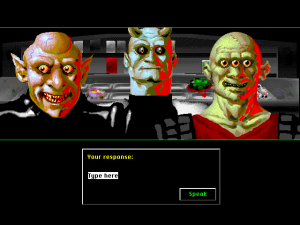
“He said that, then you said that, and where does it branch and where does it lead to? And what does it have on the emotional response of the character?”
And I actually think this is… gameplay, as we now know, helps people – especially kids that play these third-dimension [games] – it helps their 3D perspective of the world. They have an understanding of where things exist. They have a growth in their brain area for understanding landscapes and three-dimensional land [and] positioning. They’re actually learning a lot of great things. What they’re not learning about, which they really need to learn about, is human relations, like conversations, of building skills about… will you be able to talk and relate and emotionally understand people? Now that’s, I think, a real growth area for simulations in the future.
And I hope – I think – that speech recognition is somewhat… the problem is that the reason why you haven’t seen it more so is because it’s so hard. Technologically laying out the sequence of things you could say and what something could say back and how that works is incredibly complicated. Along a completely different dimension than how a bullet travels through the air or something. It’s a weird psychological dimension. It’s very complicated.
Yeah, I mean, even stuff like ELIZA was like, this huge, big, amazing, “Wow, it’s so realistic!” But nowadays, it’s very clearly just spitting back patterns. It’s always a holy grail.
“How does that make you feel?” Yeah. Having speech recognition that understands what you mean, building it into simulated reality with different personalities. That’s a huge growth area for all the game developers out there that I think could have some huge rewards. I’m not gonna do it. [laughs] I might be a consultant, but not as like… that is a ten-year ball to move forward. I mean, Google’s working on a lot of that. We’re doing a lot of that hard stuff, but not for the fun simulation reasons, or for training reasons. We’re just practical, like “Hey, where’s my car?” “Dude, where’s my car?” [robotic voice] “You parked around the corner. Here it is on the map.” You know, that kind of stuff. But personality is different.
And… that theme song
I have to ask you about the theme song. Everyone loves the theme song. Did you know it was going to be so cheesy when you were doing it? Did you intend it to be that wonderfully cheesy when you did the song?
I was just trying to make a theme song with “Spaceship Warlock”! [sings the theme for a few bars]
So that is a loop that just keeps repeating, the same way I said [with the other music]. Because it’s only four bars of me going “Warlock!” [continues to sing along] So that was just the title track music. It had to say “Spaceship Warlock.” It had to sound military, kind of guns and things. And that was it. It was just like, I was gonna make the theme for Spaceship Warlock.
When I was recording it at this time, I had been involved in MIDI music creation for a long time, and I had something called Vision. Later it would be called Studio Vision, and it was my primary music tool for many years. But at the time, the digital audio recording was not nearly as sophisticated. So it would basically… you would have all these external instruments, which to this day, I have my controller keyboard right here on my Google desk, and I use it all the time. We make commercials for all kinds of advertisers.
But at this time, all the audio was coming from these different synthesizers, like rack synthesizers and things like that. And they all that their own audio outputs, which you had to come in somewhere, and then record it. And what they were being recorded on was my TASCAM four-track tape recorder, which used that tape to record four tracks of audio. So I would record: in comes the drums, in comes the horns or whatever synthesizers, and then I would lay down my vocal track on that cassette tape. Then I would digitize the results in and find a cutting loop point. I basically performed “Spaceship Warlock” for a long time, like over a minute or two, and then I went in and found the key part of that one little segment of the audio to loop and play it and loop it just right. That became the theme song.
So it wasn’t like… today, I would just do a one-minute theme song. But back then, I had to load it on to whatever would play it. We couldn’t load gigantic audio files. So I had to load a very small audio files and play that as the theme song.

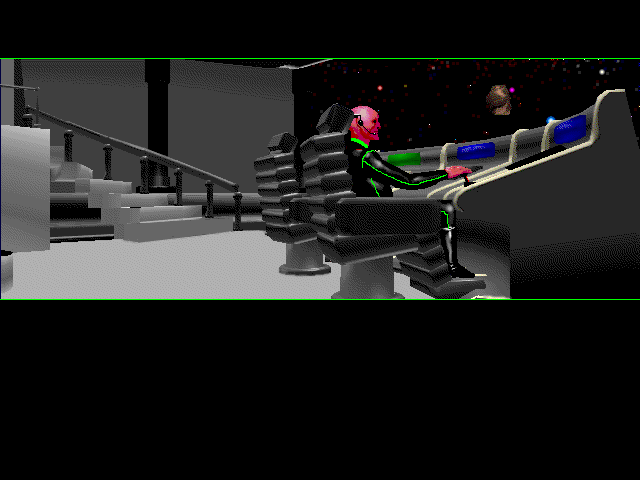
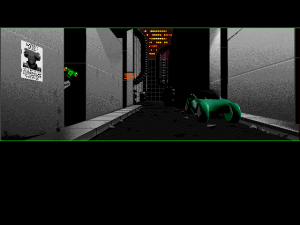
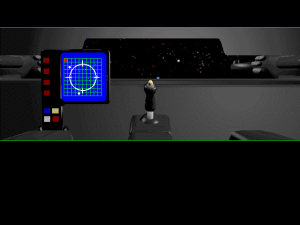
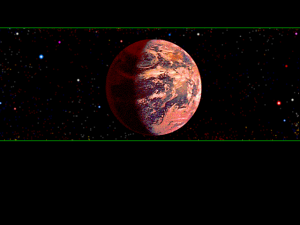

“Oh, I played that when I was a kid, it’s great!,” even though I was too young to figure out how to even leave Stambul. Once we upgraded to a new Power Macintosh (or maybe it was the switch to OS9?), the sound pooped out! So, I keep the box around (©1990 only!), and every year or two I try the latest in emulation software, but can never get the dang ol’ sound to play. I can reach the fight in the reactor room, but then it starts to fall apart without the sound. I feel like this is the sort of thing that I’ll figure out on my deathbed, and slowly make my way through the game, and then die just as the credits finish.
Funny as hell!!